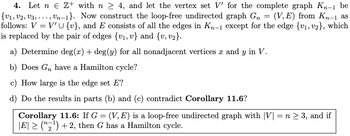
Fundamentals of Information Systems
8th Edition
ISBN: 9781305082168
Author: Ralph Stair, George Reynolds
Publisher: Cengage Learning
expand_more
expand_more
format_list_bulleted
Question
4. Let n ∈ Z+ with n ≥ 4, and let the vertex set V ′ for the complete graph Kn−1 be
{v1, v2, v3, . . . , vn−1}. Now construct the loop-free undirected graph Gn = (V, E) from Kn−1 as
follows: V = V ′ ∪ {v}, and E consists of all the edges in Kn−1 except for the edge {v1, v2}, which
is replaced by the pair of edges {v1, v} and {v, v2}.
a) Determine deg(x) + deg(y) for all nonadjacent vertices x and y in V .
b) Does Gn have a Hamilton cycle?
c) How large is the edge set E?
d) Do the results in parts (b) and (c) contradict Corollary 11.6?
PS:Please do not use ChatGPT and type the correct answer!

Transcribed Image Text:4. Let nЄ Z+ with n ≥ 4, and let the vertex set V' for the complete graph K-1 be
{V1, V2, V3, ..., Un−1}. Now construct the loop-free undirected graph G = (V,E) from KË−1 as
follows: V = V'U{v}, and E consists of all the edges in K-1 except for the edge {v1, v2}, which
is replaced by the pair of edges {v1, v} and {v, v2}.
a) Determine deg(x) + deg(y) for all nonadjacent vertices x and y in V.
b) Does G have a Hamilton cycle?
c) How large is the edge set E?
d) Do the results in parts (b) and (c) contradict Corollary 11.6?
Corollary 11.6: If G = (V,E) is a loop-free undirected graph with |V| = n ≥ 3, and if
|E| ≥ ("₂¹) +2, then G has a Hamilton cycle.
Expert Solution
This question has been solved!
Explore an expertly crafted, step-by-step solution for a thorough understanding of key concepts.
Step by stepSolved in 2 steps with 5 images

Knowledge Booster
Recommended textbooks for you
 Fundamentals of Information SystemsComputer ScienceISBN:9781305082168Author:Ralph Stair, George ReynoldsPublisher:Cengage Learning
Fundamentals of Information SystemsComputer ScienceISBN:9781305082168Author:Ralph Stair, George ReynoldsPublisher:Cengage Learning Operations Research : Applications and AlgorithmsComputer ScienceISBN:9780534380588Author:Wayne L. WinstonPublisher:Brooks Cole
Operations Research : Applications and AlgorithmsComputer ScienceISBN:9780534380588Author:Wayne L. WinstonPublisher:Brooks Cole C++ Programming: From Problem Analysis to Program...Computer ScienceISBN:9781337102087Author:D. S. MalikPublisher:Cengage Learning
C++ Programming: From Problem Analysis to Program...Computer ScienceISBN:9781337102087Author:D. S. MalikPublisher:Cengage Learning New Perspectives on HTML5, CSS3, and JavaScriptComputer ScienceISBN:9781305503922Author:Patrick M. CareyPublisher:Cengage Learning
New Perspectives on HTML5, CSS3, and JavaScriptComputer ScienceISBN:9781305503922Author:Patrick M. CareyPublisher:Cengage Learning C++ for Engineers and ScientistsComputer ScienceISBN:9781133187844Author:Bronson, Gary J.Publisher:Course Technology Ptr
C++ for Engineers and ScientistsComputer ScienceISBN:9781133187844Author:Bronson, Gary J.Publisher:Course Technology Ptr

Fundamentals of Information Systems
Computer Science
ISBN:9781305082168
Author:Ralph Stair, George Reynolds
Publisher:Cengage Learning

Operations Research : Applications and Algorithms
Computer Science
ISBN:9780534380588
Author:Wayne L. Winston
Publisher:Brooks Cole

C++ Programming: From Problem Analysis to Program...
Computer Science
ISBN:9781337102087
Author:D. S. Malik
Publisher:Cengage Learning


New Perspectives on HTML5, CSS3, and JavaScript
Computer Science
ISBN:9781305503922
Author:Patrick M. Carey
Publisher:Cengage Learning

C++ for Engineers and Scientists
Computer Science
ISBN:9781133187844
Author:Bronson, Gary J.
Publisher:Course Technology Ptr